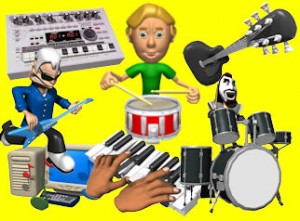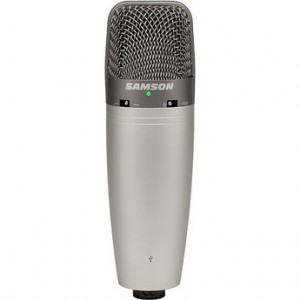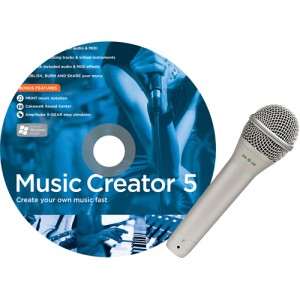 Music studio equipment can get really expensive really fast. I’m differentiating here between just any home recording studio, and one that specifically is set up for recording and producing music. If you are a voice over actor or podcaster exclusively, you can get by with quite a bit less in the way of studio gear. Musicians will almost certainly be needing, and hence, paying, more.
Music studio equipment can get really expensive really fast. I’m differentiating here between just any home recording studio, and one that specifically is set up for recording and producing music. If you are a voice over actor or podcaster exclusively, you can get by with quite a bit less in the way of studio gear. Musicians will almost certainly be needing, and hence, paying, more.
But that doesn’t mean you have to go broke. Remember that our goal at Home Brew Audio is to help you create the best quality audio for the lowest amount of money, and that is still true for the folks recording music in their home studio.
In order to make this article optimally applicable to the most folks, my example will be one or two people creating music on a computer using multitrack recording and audio editing tools. Things get pretty variable and different when you start talking about full bands or orchestras. I’m also going to assume for this example that the musicians already possess the musical instruments that will be on the recordings. Oh, and I also assume the person recording has a computer…pretty much any computer made in the last 10 years will do.
Okay, so the basics are these: you play the music, which goes through a microphone and then into a computer, which converts the sound into computer files that can be heard and manipulated by your audio software. See?! How hard is that? Alright, yes. It might be helpful to have a bit more information.
Let’s start with the first piece of music studio equipment you may not already have, the microphone. Let’s also say you are a guitarist and singer. Ultimately I would recommend two different kinds of microphones here, one for your guitar (acoustic for our example) and one for your voice. But let’s talk minimums here. We’ll go with one  microphone, a large diaphragm condenser (side address) of the USB ilk, such as the Samson C03UCW (see pic). At this wonderful point in time probably the most bang-for-the-buck you can get in audio recording is a USB microphone. They cost much less than their traditional cousins, plus they don’t require a special computer interface or microphone preamplifier. Just plug it into your computer and go. You can use the same mic for your guitar as for your voice, as we are going to be recording one part at a time. Guitar first, then singing, etc. You only need one mic at a time for that. If the $139.00 for the C03U is a bit steep, you can get very near the sound quality for only $59.99 with the Samson Q1U handheld mic.
microphone, a large diaphragm condenser (side address) of the USB ilk, such as the Samson C03UCW (see pic). At this wonderful point in time probably the most bang-for-the-buck you can get in audio recording is a USB microphone. They cost much less than their traditional cousins, plus they don’t require a special computer interface or microphone preamplifier. Just plug it into your computer and go. You can use the same mic for your guitar as for your voice, as we are going to be recording one part at a time. Guitar first, then singing, etc. You only need one mic at a time for that. If the $139.00 for the C03U is a bit steep, you can get very near the sound quality for only $59.99 with the Samson Q1U handheld mic.
So what other hardware do you need? Uh, well let’s see. Something to hold your mic while you play guitar is about the only other thing you’ll need. If your USB mic didn’t already come with one, you can get them from your local music store for cheap. Heck, if you need to you could duct-tape one to a desk or just set one on a pillow on a chair or something.
So if we’re done with hardware, what next? Yup, software. You’ll need software that can record multiple tracks and mix them together, which we’ll call tracking and mixing. You’ll also need audio editing capability. See last week’s article on PC Recording Software for more on this. Luckily there are recording software programs out there that do both functions, the lowest cost of which is free. “Audacity” is a program that is open-source freeware that can record, mix multiple tracks together AND edit audio. In fact Audacity is the most incredible value on the face of the planet. But since it is free, there are limitations, especially where musicians are concerned, such as in MIDI functionality. So you might want something with a bit more capability. There are so many choices out there for so many different prices, that it can make your head spin. Personally I use a program called Reaper, by Cockos (no affiliation) for tracking and mixing, and Adobe Audition for editing, though in truth, Audition is one of those programs that can do it all. I just prefer the ease and work flow in Reaper.
mix them together, which we’ll call tracking and mixing. You’ll also need audio editing capability. See last week’s article on PC Recording Software for more on this. Luckily there are recording software programs out there that do both functions, the lowest cost of which is free. “Audacity” is a program that is open-source freeware that can record, mix multiple tracks together AND edit audio. In fact Audacity is the most incredible value on the face of the planet. But since it is free, there are limitations, especially where musicians are concerned, such as in MIDI functionality. So you might want something with a bit more capability. There are so many choices out there for so many different prices, that it can make your head spin. Personally I use a program called Reaper, by Cockos (no affiliation) for tracking and mixing, and Adobe Audition for editing, though in truth, Audition is one of those programs that can do it all. I just prefer the ease and work flow in Reaper.
And that’s it! Yup, a computer, a usb mic and some software you can get you started with a very small budget (starting at about $25 for the mic). You’ll want a pair of headphones too, though you could get by with a regular old pair of earbuds if you have to. Then all you need to do is record that guitar part, hit “save”, add another track next to the guitar track, record your voice on that 2nd track while you listen to the first track on your headphones. Boom. You’ll probably want to add another guitar or another voice or 2 for harmonies, etc. No problem; just rinse and repeat, adding tracks as you go. When you have everything recorded, use your mixing software to pan the instruments and voices left, right, and/or in the middle like a group would be on stage. This also creates a nice stereo sound. Then make sure nobody is too loud or soft in the blend, hit “Save” again, and you’ve got a song. Now just open the song in your editing program, snip off any extra sound from the beginning (a count-in or a cough, etc.) of the recording. Fade the end out, make sure the whole thing is loud enough, save it, and you’ve got yourself a song that your recorded on your own home music studio.
Pretty cool huh? Check out the massive number of on-line tutorials out there for free, or you could go to Home Brew Audio’s site for lots of articles and videos to help you out.
Happy Recording!
Reader Interactions
Comments
Trackbacks
-
Whaddya absoltuely need for a home music studio? https://www.homebrewaudio.com/music-studio-equipment-whats-the-minimum-needed
“Audacity” is not bad if you need production software try Ableton Live 8 http://rkaudio.com/ableton-abletonlive8.html